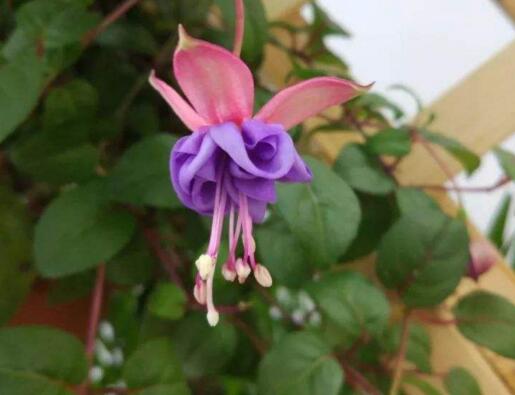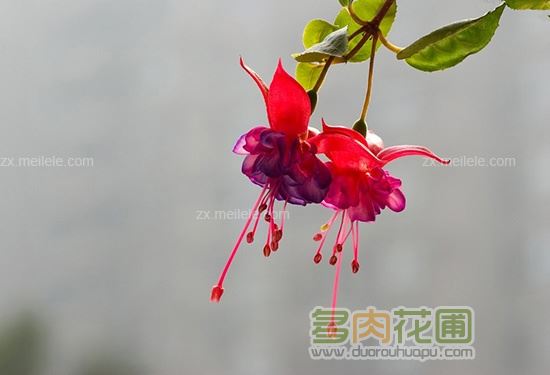How to propagate cuttings of Admiralty upside down?
Fuchsia is a perennial evergreen subshrub belonging to the genus Fuchsia in the family Salicaceae. It is also known as diaozhong flower, lantern flower, lantern begonia, diaozhong begonia, etc. Fuchsia flowers hanging upside down, like hanging colored lanterns, graceful, colorful. Long flowering period, suitable for potted plants, can be used to decorate flower beds in cool summer areas, but also for cut flowers.
Cutting propagation can be carried out in the whole growing season, spring and autumn cuttings take root faster, autumn cuttings bloom in spring and summer of the second year, so autumn cuttings are most suitable. The best cutting is the top shoot, cut into small pieces 5~10 cm long, leaving 3 upper leaflets. After harvest, immediately cut on the sand bed, or first immerse all cuttings in 0.1% potassium permanganate solution for 30 seconds, then erect to expose leaves, continue to soak the base for 30 minutes, and then immerse the base of cuttings in clear water for 24~48 hours before cutting. After cutting shade, keep the matrix moist, generally spray water once a day, temperature control about 20℃. All roots can take root in about 15 days. After rooting, move to the container with diameter of 8~10 cm and culture as soon as possible. When the seedlings are 15 - 20 cm high, they are picked.
Fuchsia can also be reproduced in water. It can also be used for seeding and tissue culture seedlings, which are not used for production at present. Tissue culture seedlings were cultured on MS medium with buds as explants.
How to reproduce the inverted bell, the cutting method/cutting treatment of the inverted bell is very important
The inverted bell has certain requirements for breeding technology and environment, so it also needs certain skills when propagating, such as the twig will wither quickly from the mother when cutting, how to ensure that it does not die before inserting the matrix requires skills, so how does the inverted bell reproduce? What is the method of cuttage of inverted bell? Let's get to know each other in detail.
How does the fuchsia reproduce?

There are three main propagation methods of Fuchsia inversion, namely cuttage, seeding and tissue culture. Cuttage propagation is recommended for family potted Fuchsia inversion; tissue culture is recommended for cultivating new varieties; large-scale greenhouse cultivation is best for seeding propagation.
Cuttings of Fuchsia sinensis
1. Time
Cuttage propagation in addition to summer, spring, autumn, winter if the temperature is appropriate can be carried out, but spring is the fastest rooting, followed by autumn, many places winter temperature is lower, so it is best to choose in spring, autumn two seasons.
2. Specific steps
(1) How to reproduce when using cuttage? First of all, prepare the substrate and sand bed. The substrate is best mixed with garden soil and river sand according to the ratio of 1:1. The stimulation to the tender roots is minimal, which is conducive to the survival of the tender roots after cutting.
(2) The second is to make cuttings. Select 1-2 year old branches from the upper part of fuchsia plant. The branches must be unlignified and have tender tips. Cut the branches into cuttings of 6-10 cm each, keep 2-3 leaves on the upper part of the cuttings, and cut off all the leaves on the lower part.
(3) Because the young shoots will wither quickly after leaving the mother, if they are directly inserted into the matrix, they will die easily. Therefore, after cutting down, soak their bases in potassium permanganate solution for 30 minutes, and then take them out and insert them into the matrix. The survival rate is higher.
(4), cutting density to the leaves do not shield each other is appropriate, the depth is one-third or half of the length of the cuttings, after planting need to be watered, and then placed in a bright place management, spray water 1-2 times a day, half 20-3 days later can take root.
(5) After rooting, it is necessary to plant in pots. Use tools to gently pick up the seedlings, and then plant them in the prepared pot soil respectively. After righting, compact them with soil, and then pour water thoroughly to keep the soil moist. After one month, you can carry out normal management according to the cultivation method of inverted bell.
How to sow the golden bell upside down
Sowing is one of the breeding methods of inverted bell with a longer effective time. Select plump seeds from mature fruits, and sow in spring and autumn, the temperature needs to be kept at 15-20℃, the method is broadcast, generally 15 days after sowing will germinate, only spring sowing can see fuchsia flowering in the second year.
A detailed introduction to the method and steps of cuttage propagation of Fuchsia sinensis
When it comes to hanging upside down, I believe everyone will not be unfamiliar with it. Fuchsia is a common herbaceous flower with high ornamental value and is loved by many flower friends. So, do you know what the method steps of cuttage propagation of inverted bell are? Today, Xiao Bian will introduce relevant knowledge to everyone in detail.
1. Cutting time
In addition to summer dormancy period, other time as long as the temperature is appropriate, can be cuttage, but in November of each year to the middle and early April of the following year is good. Because this period of time is the peak season for plant growth, the cuttings with strong vitality can be selected, and the temperature is cooler, the cuttings should not rot, and the survival rate is higher.
2. Selection of cuttings
Cuttings should be selected that year, not yet lignified branches, preferably with tender tips, the length of the cuttings is generally 6 to 10 cm, the lower leaves should be cut off. It should be noted that when cutting ears, be sure to use sterilized scissors to make the cutting mouth neat and smooth. Do not pinch the cutting ears directly on the plant by hand.
3. Preparation of cutting substrate and cutting bed
Cuttage substrate had better be sieved fine river sand, but must be scalded and disinfected with boiling water. Bed can be used shallow basin or wooden box, in advance also with 0.1% potassium permanganate solution spray disinfection.
4. Cutting method
When cutting, first soak the cuttings in vitamin B12 for 20 minutes, insert a small hole in the sand with a thin bamboo stick, and then insert the cuttings into the sand hole, the depth is 3 to 4 cm, and the spacing of the cuttings needs to be maintained at about 8 cm, so as to facilitate the pot after rooting. After cutting, pour a permeable water, cover with plastic cloth, keep the humidity of the cutting bed.
5. Post-insertion management
Cuttings should be placed in the room after the astigmatism of the place, not directly accept sunlight, room temperature to maintain at about 20 degrees Celsius, after a week to make it accept some light. After cutting, water should be sprayed into the cutting bed frequently, once a day in winter and once a day in the morning and evening in spring, so that the humidity in the cutting bed is maintained at more than 80%. Rooting usually takes place in about 25 days in winter and about 20 days in spring.
6, seedlings on the pot
Cuttage seedlings should be timely after taking root on the pot, pot soil application of non-fertilizer sandy loam, pots and cultivation soil should be disinfected, pot bottom with broken pot pieces to do a good drainage layer. When transplanting, the seedlings can be gently dug up with a small bamboo shovel, put into a small pit dug in advance in the basin, and bury the roots with soil after being placed upright. Do not press the soil with hands to avoid excessive force and damage to the roots and seedlings. After the seedlings are planted, they need to be watered once immediately to make the soil naturally dense, and then placed in the shade to cultivate them. If the leaves do not wilt after three days, they can be exposed to light. After one month, apply less liquid fertilizer and enter normal management.
The above is all I know about the inverted bell today. I hope that after reading this article, my flower friends will be helpful. If you want to know more about the inverted bell, please continue to pay attention to the fleshy flower garden. We will provide you with more relevant knowledge!
- Prev

How to breed and cultivate the golden bell upside down?
Upside down Admiralty is mainly propagated by cuttings, as well as by sowing and grafting. Cuttings can be cut all year round, and cuttings take root most quickly in spring and autumn. The strong shoots at the top of the plant are the best for cuttings. The long 5~8cm of the cuttings is cut in a plain sand bed to keep shade and moisturize. The suitable temperature is 15: 20 ℃.
- Next

The breeding method of hanging Golden Bell upside down
Originally from tropical America and New Zealand. I like a cool and humid environment. It is not resistant to high temperature, and the suitable temperature for growth is 10-15 ℃. It is suitable for fertile sandy loam with rich humus and good drainage. 1. Propagation methods (1) sowing and propagating some varieties that are easy to bear fruit can be sowed and propagated, and sown in spring and autumn greenhouse with seedling trays.
Related
- Fuxing push coffee new agricultural production and marketing class: lack of small-scale processing plants
- Jujube rice field leisure farm deep ploughing Yilan for five years to create a space for organic food and play
- Nongyu Farm-A trial of organic papaya for brave women with advanced technology
- Four points for attention in the prevention and control of diseases and insect pests of edible fungi
- How to add nutrient solution to Edible Fungi
- Is there any good way to control edible fungus mites?
- Open Inoculation Technology of Edible Fungi
- Is there any clever way to use fertilizer for edible fungus in winter?
- What agents are used to kill the pathogens of edible fungi in the mushroom shed?
- Rapid drying of Edible Fungi

